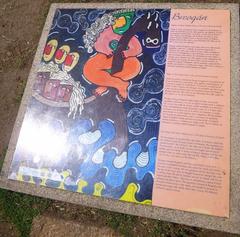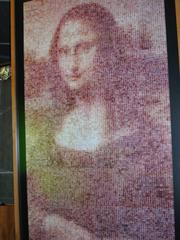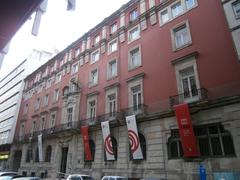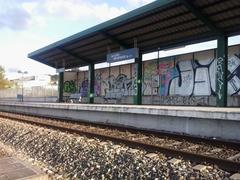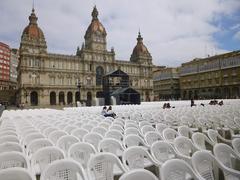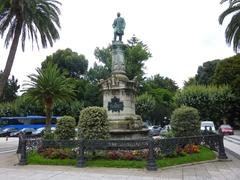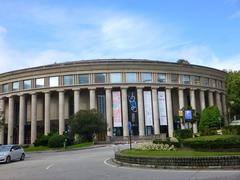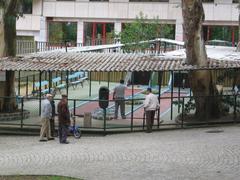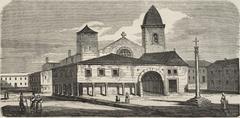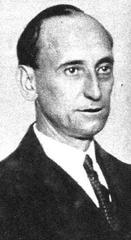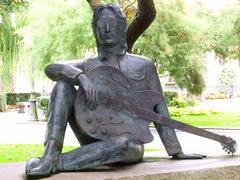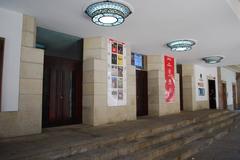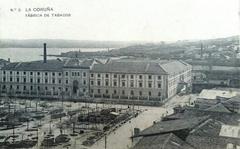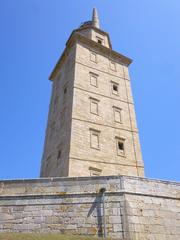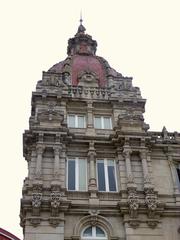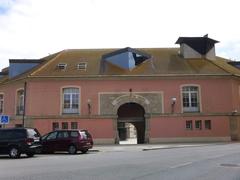
Edificio De Correos Da Coruña: Visiting Hours, Tickets, and Travel Guide
Date: 04/07/2025
Introduction
Nestled in the heart of A Coruña, the Edificio De Correos Da Coruña is more than just a central post office—it’s a testament to the city’s 20th-century modernization, civic pride, and architectural innovation. Designed in 1931 by Joaquín Otamendi Machimbarrena and Luis Lozano Losilla, this prominent structure exemplifies Spanish Rationalist architecture. Today, it stands as a must-see destination for architecture enthusiasts, history lovers, and curious travelers eager to explore A Coruña’s vibrant past and present (Docomomo Ibérico; María Berini, 2016).
This comprehensive guide provides essential information for visiting the Edificio De Correos, including opening hours, accessibility, historical context, architectural highlights, nearby attractions, and practical travel tips to enrich your journey in A Coruña.
Table of Contents
- Historical Context & Urban Development
- Architectural Style & Key Features
- Visiting Information
- Visitor Experience & Practical Tips
- Nearby Attractions
- Events & Community Engagement
- FAQs
- Summary & Travel Tips
- References
Historical Context & Urban Development
The Edificio De Correos Da Coruña arose during a period of significant urban expansion in A Coruña. As the city’s population and economic activity grew, so did the need for efficient public infrastructure. Its strategic location between Ambrosio Feijóo and Alcalde Manuel Casás streets placed it at the administrative and commercial epicenter of the city (La Opinión A Coruña; infocorreos.es). The building occupies a full city block and is within walking distance of landmarks such as Plaza de María Pita and the historic Old Town (Turismo de Galicia).
Constructed during the interwar period, the Edificio De Correos marks a shift in A Coruña’s urban landscape, reflecting Spain’s drive toward functional, modern civic spaces (María Berini, 2016).
Architectural Style & Key Features
Rationalism and Modernity
The building is a prime example of Spanish Rationalist architecture, characterized by geometric clarity, functional design, and minimal ornamentation. Its clean lines, robust stonework, large regularly spaced windows, and a distinctive stepped tower embody the rationalist ethos while nodding to modernist influences from across Europe (Docomomo Ibérico).
Exterior and Interior Highlights
- Façade: Symmetrical, white surfaces with subtle Art Deco features and a prominent tower (Elespanol).
- Interior: Spacious halls, high ceilings, and abundant natural light. The functional H-shaped floor plan reflects both efficiency and the building’s status as a civic anchor.
- Materials: Reinforced concrete structure, stone cladding, and durable finishes consistent with early 20th-century construction standards.
Visiting Information
Opening Hours
- Monday to Friday: 08:30 – 20:30 (infocorreos.es)
- Saturday: 09:00 or 10:00 – 14:00 (Check Correos.es or call for exact times)
- Sunday/Public Holidays: Closed
Always confirm hours during holidays or special city events.
Tickets & Entry
- Admission: Free; no ticket required for general visits.
- Areas Open to Public: Main postal hall and customer service spaces. Administrative and restricted areas are not open to visitors.
Accessibility
- Wheelchair Access: Ramps, wide entrances, and elevators are available.
- Facilities: Accessible restrooms and customer seating are provided.
- Public Transport: Multiple bus lines and nearby taxi ranks serve the area (horarioscorreos.com).
Visitor Experience & Practical Tips
- Atmosphere: The building is lively on weekdays, with a steady flow of local residents and postal activity. Its proximity to busy shopping and leisure zones adds to the vibrant urban feel.
- Photography: The best exterior shots are captured in the morning or late afternoon. Interior photography is generally permitted in public areas—avoid photographing staff or customers without consent.
- Cultural Context: The Edificio De Correos often features in city walking tours, especially those focused on modernist or rationalist architecture (Brogan Abroad).
- Language: Staff usually speak Spanish and Galician; some may speak basic English.
- Amenities: Restrooms, free Wi-Fi (in some zones), and philatelic counters for stamp collectors.
- Souvenirs: Commemorative stamps and postcards can be purchased at the philately counter.
Nearby Attractions
Make the most of your visit by exploring these nearby sites:
- Plaza de María Pita: The city’s main square with the Town Hall (Brogan Abroad).
- Avenida da Marina: Known for its iconic glass-fronted galleries (Rough Guides).
- Castelo de San Antón: 16th-century fortress and archaeological museum (Spain Guide Now).
- Museo de Belas Artes da Coruña: Renowned for its Galician and Spanish art (Spain.info).
Events & Community Engagement
Throughout the year, the Edificio De Correos hosts community events, art exhibitions, and educational activities that celebrate postal history and local culture. Its central location and spacious halls make it an ideal venue for temporary exhibitions and public gatherings (La Opinión A Coruña).
FAQs
Q: Are there any admission fees or tickets required to visit?
A: No, visiting the Edificio De Correos is free of charge.
Q: What are the visiting hours?
A: Monday to Friday, 08:30–20:30; hours may vary on Saturdays and holidays.
Q: Is the building wheelchair accessible?
A: Yes, with ramps, elevators, and accessible restrooms.
Q: Are guided tours available?
A: No official tours, but the building is featured in city walking tours (Brogan Abroad).
Q: Can I take photographs inside?
A: Yes, in public areas. Please be respectful and avoid photographing staff or customers without permission.
Q: What services are available at the post office?
A: Mail and parcel delivery, philatelic sales, and administrative services.
Q: How do I get there?
A: Centrally located and served by public transport; address: Alcalde Manuel Casás s/n, 15002 A Coruña (infocorreos.es).
Summary & Travel Tips
The Edificio De Correos Da Coruña is a distinguished symbol of A Coruña’s architectural and civic evolution. Its rationalist design, historical role, and central location make it an essential stop for anyone interested in the city’s heritage. Free to enter and fully accessible, it is easy to combine with nearby attractions for a rich, day-long exploration of A Coruña.
Travel tips:
- Visit during off-peak hours for a quieter experience.
- Combine your visit with a stroll through Plaza de María Pita and Avenida da Marina.
- Consider purchasing commemorative stamps as unique souvenirs.
- Check local cultural calendars for special exhibitions or events (Audiala).
For a seamless experience, download the Audiala app for up-to-date visitor information, audio guides, and cultural highlights. Stay connected through official tourism channels for the latest updates on events and exhibitions (Visit Coruña).



